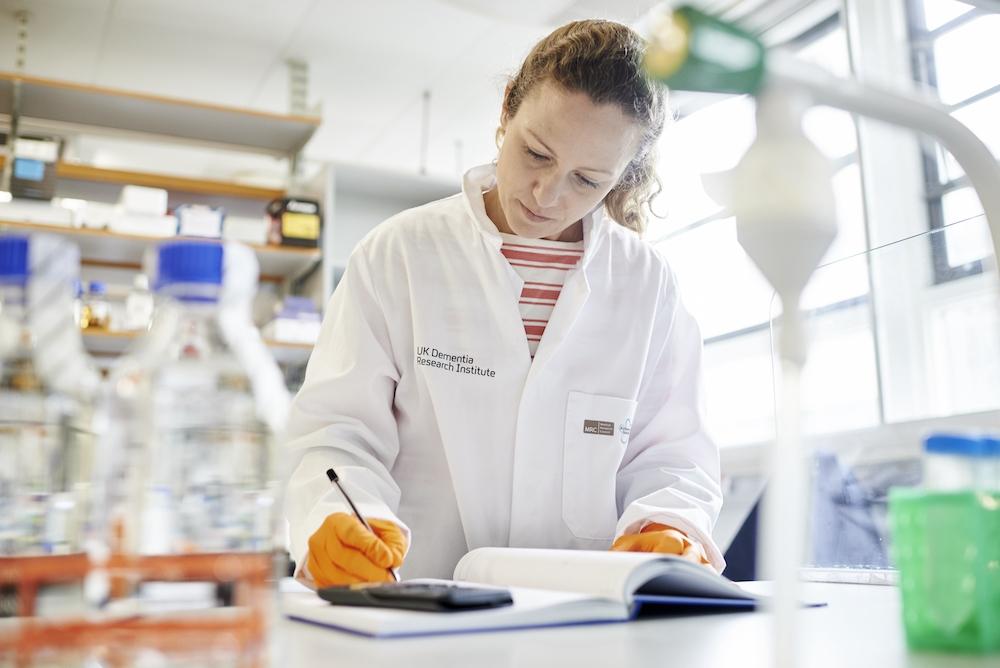Dementia research is at a turning point. Two new drugs, lecanemab and donanemab, have demonstrated for the first time that the progress of Alzheimer’s disease – the most common cause of dementia – can be slowed. This is momentous news for the millions of people affected by dementia globally, and these treatments are a significant step towards a world where dementia can be stopped altogether. But these drugs are just the start of the story.
Dementia is a highly complex condition, which can be caused by several different diseases, involving many different systems in the body. Medical research has made great strides in recent decades, but research into dementia has lagged behind other disease areas, largely due to historic under-resourcing and underfunding. As a result, there are significant gaps in our knowledge of the underlying causes of neurodegeneration.
To achieve our mission of stopping dementia in its tracks and improving the lives of people affected by the condition, these gaps need to be addressed. This World Alzheimer’s Month, we’re taking a closer look at some of the knowledge gaps in dementia research, and how researchers at the UK DRI are filling them.
Defining the knowledge gap
Dementia is an umbrella term for a group of symptoms caused by different diseases that damage the brain. The symptoms get worse over time and can include memory loss, confusion and changes in behaviour. Alzheimer’s is the most common disease that causes dementia.
Alzheimer’s disease is a complex condition, characterised by the gradual deterioration of memory. We know that people who have Alzheimer’s disease have mutated versions of two proteins present in their brains, amyloid and tau, which clump and form structures called plaques and tangles. The condition leads to the death of neurons, a type of brain cell.
Lecanemab and donanemab work by reducing the amount of amyloid beta protein in the brain. However, this is not the whole picture, as exactly how the build-up of amyloid leads to the death of brain cells is not yet well understood.
people are currently living with dementia in the UK

are filling the dementia knowledge gap with vital discovery research
We also do not know how amyloid interacts with tau, and how each protein contributes to the progression of the disease. Even more curiously, some people may have a build-up of amyloid in their brain, but experience none of the symptoms of dementia. This phenomenon may offer clues to how we could treat people affected by dementia – understanding why some are seemingly protected from the disease could lead to new therapies.
Beyond amyloid and tau, there are many other biological mechanisms that feed into the development and progression of Alzheimer’s. For instance, apart from neurons, what role do other cells in the brain play in the disease? How are the immune and vascular systems involved? Understanding the interplay between all these different components is key if we are to effectively treat Alzheimer’s – and UK DRI scientists are investigating this right now.
Age is the biggest risk factor for Alzheimer’s, and more research is needed to understand why this is the case. Other factors like genetics, sex, ethnicity, and lifestyle factors including smoking and sleep, also feed in. These are all promising avenues to explore, and further understanding of how these risk factors impact disease development is another important piece of the puzzle that our scientists are seeking to solve.
When it comes to treatment, clinical trials of lecanemab and donanemab have proven that early diagnosis is key to ensuring people receive drugs when they are most likely to be effective. However, we do not currently have a method of diagnosing people at scale, accurately and early enough for new drugs to be delivered when they are most effective. Promising research is underway to develop new, accurate and scalable diagnostic tools, which will enable us to identify people who have Alzheimer’s at an earlier stage – possibly even before they start to experience symptoms.
Filling the gap with new discoveries
The problem may feel vast, but there is hope. Scientists at the UK DRI are conducting vital, world-leading discovery research into all areas of dementia. Tackling Alzheimer’s from multiple angles, and with cutting-edge techniques, our researchers are helping to fill the knowledge gap with fundamental research that will deepen our understanding, and ultimately lead to more effective diagnostic tools and treatment methods for dementia. It’s a long road to travel, but we have assembled a team of over 800 researchers, all working each day to make progress.
Over the course of this month, we’re going to highlight some of the amazing work our researchers are doing, introduce some of our rising star early career researchers, and talk in more depth about current progress in the field and where the next advance might come from. Follow our campaign on social media using the hashtag #FillingTheGaps.
Article published: 1 September 2023
Banner image: Thomas Angus, Imperial College London
